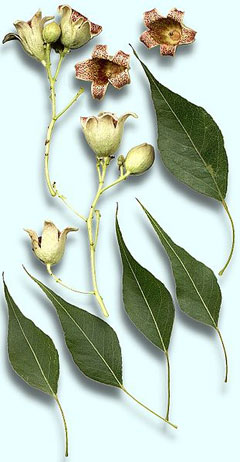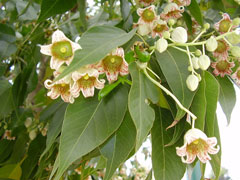 |
|
http://commons.wikimedia.org/wiki/User:JMK |
 |
| http://commons.wikimedia.org/wiki/User:Pikiwikisrael |
Translate this page:
Summary
Bloom Color: Pink, Red.
Main Bloom Time: Early summer, Early spring, Late summer, Late spring, Mid summer, Mid spring. Form: Oval, Rounded.
Physical Characteristics

 brachychiton populneus is an evergreen Tree growing to 18 m (59ft) by 18 m (59ft) at a fast rate.
brachychiton populneus is an evergreen Tree growing to 18 m (59ft) by 18 m (59ft) at a fast rate.
See above for USDA hardiness. It is hardy to UK zone 10. It is in leaf all year, in flower from May to July. The species is monoecious (individual flowers are either male or female, but both sexes can be found on the same plant).
Suitable for: light (sandy), medium (loamy) and heavy (clay) soils and prefers well-drained soil. Suitable pH: mildly acid, neutral and basic (mildly alkaline) soils. It cannot grow in the shade. It prefers dry or moist soil.
UK Hardiness Map
US Hardiness Map
Synonyms
B. diversifolium.
Plant Habitats
Woodland Garden Secondary; Sunny Edge; Dappled Shade;
Edible Uses
Edible Parts: Root Seed
Edible Uses: Coffee
Seed - raw or roasted[144, 154, 183]. A popular Aboriginal food, they are also acceptable to western palates, especially when roasted[193]. Very nutritious, containing about 18% protein, 25% fat plus high levels of zinc and magnesium[193]. The roasted seed is used as a coffee substitute[144, 183]. Root - yam-like[144, 154]. A popular food item with the Australian Aborigines[183]. The root of very young trees is used[193].
References More on Edible Uses
| Composition
|
| Figures in grams (g) or miligrams (mg) per 100g of food.
|
|
|
Seed (Fresh weight)
|
|
- 0 Calories per 100g
- Water : 0%
- Protein: 18g; Fat: 25g; Carbohydrate: 0g; Fibre: 0g; Ash: 0g;
- Minerals - Calcium: 0mg; Phosphorus: 0mg; Iron: 0mg; Magnesium: 0mg; Sodium: 0mg; Potassium: 0mg; Zinc: 0mg;
- Vitamins - A: 0mg; Thiamine (B1): 0mg; Riboflavin (B2): 0mg; Niacin: 0mg; B6: 0mg; C: 0mg;
- Reference: [ ]
- Notes:
|
|
Medicinal Uses
Plants For A Future can not take any responsibility for any adverse effects from the use of plants. Always seek advice from a professional before using a plant medicinally.
None known
References More on Medicinal Uses
The Bookshop: Edible Plant Books
Our Latest books on Perennial Plants For Food Forests and Permaculture Gardens in paperback or digital formats.

Edible Tropical Plants
Food Forest Plants for Hotter Conditions: 250+ Plants For Tropical Food Forests & Permaculture Gardens.
More

Edible Temperate Plants
Plants for Your Food Forest: 500 Plants for Temperate Food Forests & Permaculture Gardens.
More

More Books
PFAF have eight books available in paperback and digital formats. Browse the shop for more information.
Shop Now
Other Uses
Fibre
A fibre is obtained from the inner bark - it is used for making cordage, nets and dilly bags[156, 167, 193].
Special Uses
References More on Other Uses
Cultivation details
Landscape Uses:Pest tolerant, Specimen. Prefers a well-drained moderately fertile soil in a sunny position[200]. Succeeds in most soils, tolerating dry soils in Australian gardens[157, 167]. Plants dislike wet soils, especially in the winter[K]. Requires a minimum temperature of 7 - 10°c[188, 200]. Plants are hardy to at least -7°c in Australian gardens[157], though this cannot be translated directly to British gardens due to our cooler summers and longer, colder and wetter winters. This plant is very doubtfully hardy outdoors in Britain, though plants in an unheated greenhouse survived a prolonged cold period in 1996 - 97 when temperatures sometimes went down to -8°c[K]. Special Features:Not North American native, Attractive flowers or blooms.
References Carbon Farming Information and Carbon Sequestration Information
Temperature Converter
Type a value in the Celsius field to convert the value to Fahrenheit:
Fahrenheit:
The PFAF Bookshop
Plants For A Future have a number of books available in paperback and digital form. Book titles include Edible Plants, Edible Perennials, Edible Trees,Edible Shrubs, Woodland Gardening, and Temperate Food Forest Plants. Our new book is Food Forest Plants For Hotter Conditions (Tropical and Sub-Tropical).
Shop Now
Plant Propagation
Seed - we have no details for this species but suggest sowing the seed in spring in a greenhouse. When they are large enough to handle, prick the seedlings out into individual pots and grow them on in the greenhouse for at least their first winter. Plant them out into their permanent positions in late spring or early summer, after the last expected frosts. Cuttings of mature wood of the current season's growth.
Other Names
If available other names are mentioned here
Native Plant Search
Search over 900 plants ideal for food forests and permaculture gardens. Filter to search native plants to your area. The plants selected are the plants in our book 'Plants For Your Food Forest: 500 Plants for Temperate Food Forests and Permaculture Gardens, as well as plants chosen for our forthcoming related books for Tropical/Hot Wet Climates and Mediterranean/Hot Dry Climates. Native Plant Search
Found In
Countries where the plant has been found are listed here if the information is available
Weed Potential
Right plant wrong place. We are currently updating this section.
Please note that a plant may be invasive in one area but may not in your area so it’s worth checking.
Conservation Status
IUCN Red List of Threatened Plants Status :

Growth: S = slow M = medium F = fast. Soil: L = light (sandy) M = medium H = heavy (clay). pH: A = acid N = neutral B = basic (alkaline). Shade: F = full shade S = semi-shade N = no shade. Moisture: D = dry M = Moist We = wet Wa = water.

Expert comment
Author
(Schott.&Endl.)R.Br.
Botanical References
154200
Links / References
For a list of references used on this page please go here
Readers comment